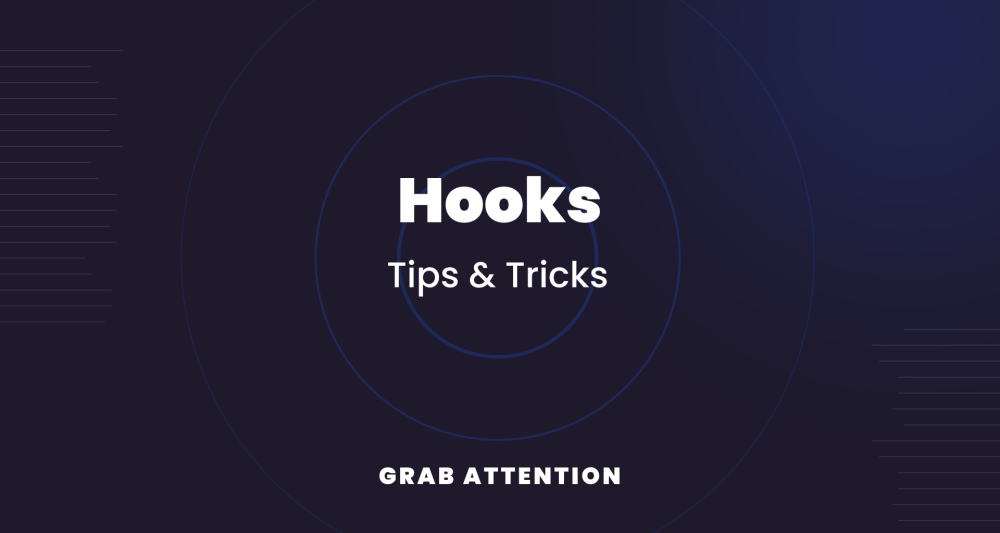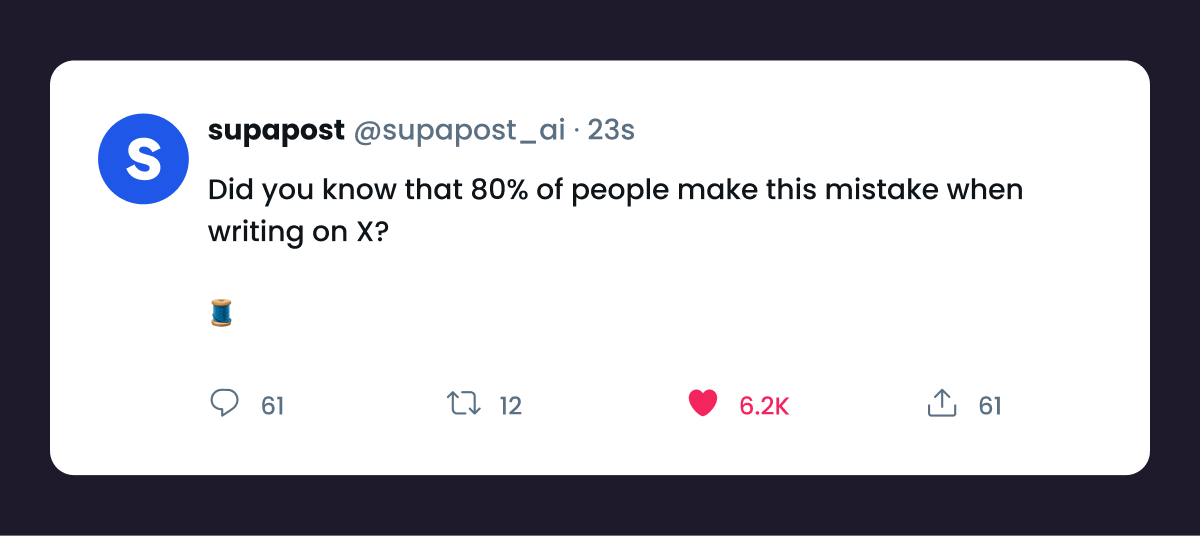Twitter Hooks: How to Capture Attention Written on . Posted in Best practices.

When it comes to content on X (formerly known as Twitter), capturing your audience’s attention within seconds is crucial. Irresistible hooks are essential tools for enhancing engagement on social media, particularly Twitter. With endless scrolling and content overload, you need a way to stop thumbs in their tracks. That’s where a powerful hook comes in. A good hook draws your audience in, piques their curiosity, and makes them eager to read more. In this guide, we’ll explore different types of hooks and how to craft ones that truly resonate.
What is a Hook?
A hook is the opening line of your post—the part that captures the reader’s attention. Think of it as your post’s headline or the first sentence of your story. It’s the first thing users see, and it often determines whether they keep reading, engage, or just scroll past.
The best hooks trigger an emotional response or curiosity, creating a “must-know” moment for the reader. Whether it’s humor, a surprising fact, or an intriguing question, an effective hook makes the difference between getting noticed and getting ignored.
Types of Twitter Thread Hooks to Use on X
1. Questions That Create Curiosity
Starting your post with a thought-provoking question is one of the easiest ways to engage the reader's attention. A question immediately involves the reader, making them think about their answer and encouraging them to read on for more context or insight.
For more guidance on increasing engagement, check out our article on Creating Viral Content on X (Twitter).
Examples:
-
“Did you know that 80% of people make this mistake when writing on X?”
-
“How would your business change if you could double your engagement?”
-
“What’s the one thing holding back your brand’s growth on X?”

2. Bold or Controversial Statements
Bold claims, especially if they go against common beliefs, are great for capturing attention. These types of hooks make people stop and think, or even want to debate. A compelling lead-in tweet with a bold statement can serve as a powerful hook to capture the reader's interest.
Want to learn how to effectively grow your personal brand on X? Visit our guide on Building a Personal Brand on X.
Examples:
-
“You don’t need a massive following to succeed on X—you need this.”
-
“Most people are using hashtags wrong, and it’s killing their reach.”
-
“Traditional social media strategy is dead. Here’s what works now.”
3. Surprising Facts or Statistics
Surprising statistics or unexpected facts can create an instant “aha” moment for your audience. These hooks work particularly well if the information you share is unusual or challenges preconceived notions. A surprising fact in the first tweet can create an instant “aha” moment for your audience.
For more insights into using statistics to boost your engagement, read our article on The 10 Most Liked X (Twitter) Posts.
Examples:
-
“Posts with questions get 23% more engagement on X.”
-
“Only 15% of users are maximizing their hashtag strategy effectively.”
-
“Did you know that engagement drops by 40% if you post at the wrong time?”
4. Personal Anecdotes
Sharing a personal story or experience as your hook can humanize your post and help people connect with you on an emotional level. Stories are powerful because they create empathy and relatability. Personal anecdotes can be particularly effective in a Twitter thread, helping to humanize your post and connect with your audience.
To get inspiration for using personal storytelling effectively, take a look at our article on How to Post on X (Twitter).
Examples:
-
“When I first started on X, I had no idea what I was doing—here’s how I turned it around.”
-
“I failed miserably with my first 100 tweets. Here’s what I learned.”
-
“Last month, I made a small change to my posting strategy that doubled my engagement.”
5. Fear of Missing Out (FOMO)
Leveraging FOMO is a great way to create urgency. If your audience feels like they might be missing out on valuable information or an opportunity, they’re more likely to keep reading. Leveraging FOMO in a thread can create urgency and encourage readers to keep reading.
Examples:
-
“The secret to doubling your followers? Most people overlook it.”
-
“Only a few people know this trick to get more retweets.”
-
“Act now—these engagement tips won’t work for long.”
If you’re looking for more structured help, explore our Twitter Post Template Guide to streamline your content creation process.
How to Craft a Great Hook
1. Know Your Audience
To write a compelling hook, you need to understand what matters to your Twitter audience. What problems do they face? What are their goals? Tailor your hooks to speak directly to those needs and interests.
2. Use Strong, Action-Oriented Language
Hooks should be punchy and to the point, just like a well-crafted tweet. Avoid passive language, and instead use words that spark action or emotion. For example, words like “discover,” “transform,” or “double” can make a big impact.
3. Keep It Concise
Threads on Twitter are already short by nature, and your hooks in threads should be even more concise. Aim for a single line that gets to the heart of what you want to convey.
4. Experiment and Test
Not every hook will work the same way for every audience. Experiment with different types of hooks to see what resonates most with your followers. Track engagement metrics like replies, retweets, and likes to understand which hooks work best. Experimenting with different hooks is a step towards becoming a Twitter master.
Examples of Effective Hooks
Here are some real-world examples of hooks that work well on X:
-
Provocative Question: “Why are most marketers getting this one thing wrong about X marketing?”
-
Bold Statement: “Your brand doesn’t need more posts—it needs better hooks.”
-
Personal Anecdote: “I used to think X was all about luck. Then I discovered this framework.”
-
FOMO Hook: “Missed this yesterday? Here’s why it matters for your social strategy.”
Here are some examples of effective Twitter thread hooks that capture attention.
Leveraging Hooks to Go Viral
Hooks are a fundamental part of creating viral content. If you want to learn more about what makes a post go viral, check out our guide on Creating Viral Content on X (Twitter): Tips and Tricks. Combine the power of a strong hook with other best practices to increase your post’s chances of being shared far and wide. Leveraging hooks effectively can significantly grow your Twitter account.
Final Thoughts on Hooks for X
Crafting effective hooks is both an art and a science. It requires a mix of creativity, audience understanding, and strategic thinking. By mastering the use of hooks, you can create posts that not only capture attention but also drive higher engagement and encourage conversation. Mastering the art of the thread hook can dramatically enhance your engagement on X.
Ready to transform your X posts? Start experimenting with these hook styles and see what resonates best with your audience. And remember—practice makes perfect. The more you test and tweak, the more you’ll improve your hook-writing skills.
